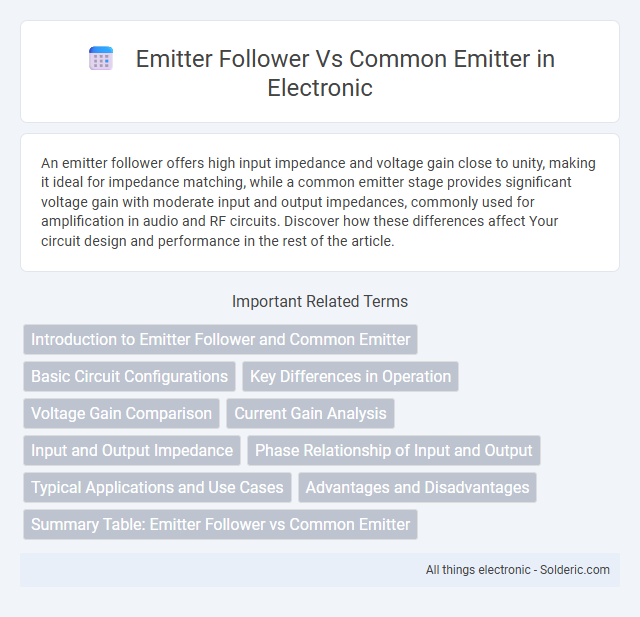An emitter follower offers high input impedance and voltage gain close to unity, making it ideal for impedance matching, while a common emitter stage provides significant voltage gain with moderate input and output impedances, commonly used for amplification in audio and RF circuits. Discover how these differences affect Your circuit design and performance in the rest of the article.
Comparison Table
| Feature | Emitter Follower (Common Collector) | Common Emitter |
|---|---|---|
| Voltage Gain | Approximately 1 (unity) | High voltage gain (up to 100 or more) |
| Current Gain | High current gain | Moderate current gain |
| Input Impedance | High (kilo-ohms to mega-ohms) | Moderate (kilo-ohms) |
| Output Impedance | Low (tens of ohms) | High (kilo-ohms) |
| Phase Shift | 0deg (no phase inversion) | 180deg phase inversion |
| Typical Use | Impedance matching, voltage buffering | Voltage amplification |
| Configuration Symbol | Transistor with output from emitter | Transistor with output from collector |
Introduction to Emitter Follower and Common Emitter
Emitter follower and common emitter are two fundamental transistor amplifier configurations used in electronics. The emitter follower, known for its high input impedance and low output impedance, provides voltage gain close to unity, making it ideal for impedance matching. Common emitter offers significant voltage gain and phase inversion, commonly employed in signal amplification where power gain is essential for your circuit.
Basic Circuit Configurations
The emitter follower configuration, also known as the common-collector amplifier, features the input signal applied to the base with the output taken from the emitter, providing high input impedance and low output impedance. In contrast, the common emitter configuration applies the input signal to the base and takes the output from the collector, delivering significant voltage gain and moderate input impedance. These basic circuit arrangements define their distinct voltage, current, and impedance characteristics essential for amplifier design.
Key Differences in Operation
Emitter follower configuration operates with a voltage gain close to unity, providing high input impedance and low output impedance, ideal for impedance matching applications. Common emitter configuration delivers significant voltage gain with moderate input impedance and high output impedance, making it suitable for signal amplification. Your choice between the two depends on whether voltage gain or impedance matching is the priority in your circuit design.
Voltage Gain Comparison
The emitter follower configuration typically provides a voltage gain slightly less than or equal to one, making it ideal for impedance matching and buffering applications. In contrast, the common emitter configuration offers a significantly higher voltage gain, often ranging from 20 to 200, which makes it suitable for signal amplification. Understanding these voltage gain differences helps you select the appropriate transistor setup to optimize your circuit's performance based on gain requirements.
Current Gain Analysis
The emitter follower configuration, also known as the common collector, provides a current gain close to unity, allowing it to act as a buffer with high input impedance and low output impedance. In contrast, the common emitter configuration exhibits a much higher current gain, typically ranging from 20 to 200, due to the transistor's beta (b), making it suitable for amplification purposes. Current gain in a common emitter circuit is determined by b (hFE), while in an emitter follower, the current gain approaches 1 because the output current closely follows the input current.
Input and Output Impedance
The emitter follower configuration features a high input impedance, typically in the range of tens to hundreds of kilo-ohms, and a low output impedance around a few ohms to a few hundred ohms, making it ideal for impedance matching and buffering applications. In contrast, the common emitter configuration exhibits moderate input impedance, usually in the kilo-ohm range, and a relatively high output impedance, often several kilo-ohms, which makes it suitable for voltage amplification but less effective in driving low-impedance loads. Understanding these impedance characteristics is crucial for selecting the appropriate transistor configuration in analog circuit design.
Phase Relationship of Input and Output
The emitter follower configuration exhibits a phase relationship where the output voltage is in phase with the input voltage, meaning there is no phase inversion. In contrast, the common emitter configuration produces an output voltage that is 180 degrees out of phase with the input voltage, leading to signal inversion. This fundamental difference affects signal processing and amplification strategies in electronic circuits.
Typical Applications and Use Cases
Emitter follower circuits, known for their high input impedance and low output impedance, are typically used in impedance matching and voltage buffering applications, such as audio amplifiers and signal conditioning. Common emitter configurations, with their high voltage gain and moderate input/output impedances, are widely utilized in amplifier stages, switching circuits, and signal amplification for RF and audio frequencies. Both circuit types play critical roles in analog electronics, with emitter followers prioritizing signal integrity and common emitters emphasizing gain and phase inversion.
Advantages and Disadvantages
The emitter follower offers high input impedance and low output impedance, making it ideal for impedance matching and signal buffering, but it provides no voltage gain, limiting its use where amplification is needed. Common emitter amplifiers deliver significant voltage gain and phase inversion, which is beneficial for signal amplification, though they suffer from moderate input impedance and lower linearity compared to emitter followers. Your choice between these transistor configurations depends on whether you prioritize voltage gain or impedance matching in your circuit design.
Summary Table: Emitter Follower vs Common Emitter
The emitter follower offers high input impedance, low output impedance, and unity voltage gain, ideal for impedance matching and buffering applications. The common emitter configuration provides moderate input impedance, high voltage gain, and phase inversion, making it suitable for amplification purposes. Your choice depends on whether voltage gain or impedance matching is the priority in your circuit design.
Emitter follower vs Common emitter Infographic

 solderic.com
solderic.com